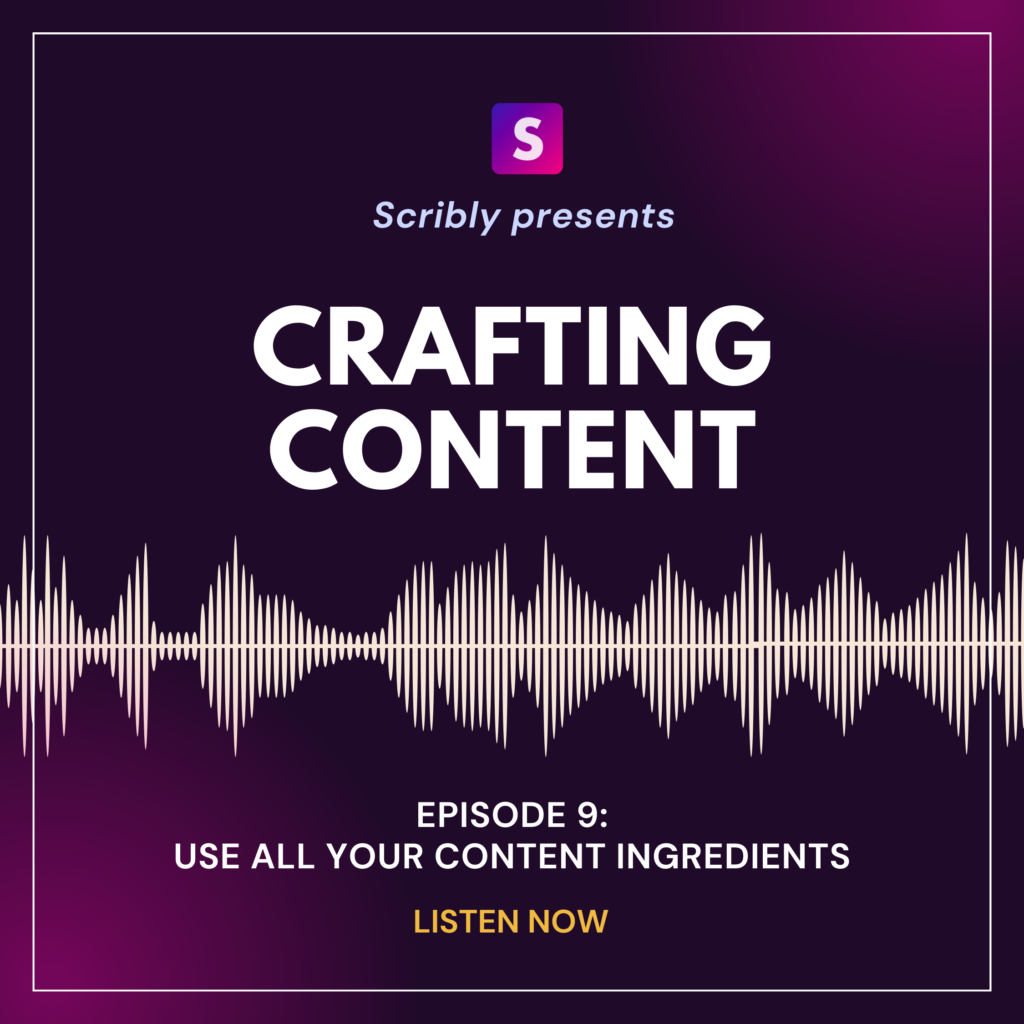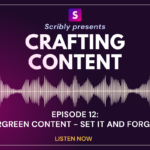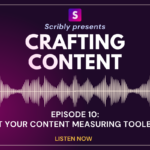Crafting Content, Episode 9 – A content marketing podcast from Scribly
Crafting Content Episode 9: Use all your content ingredients
The ninth episode of Scribly’s “Crafting Content” podcast is here! In this content marketing podcast, we share insights, top tips, and real-world examples to help you develop your content marketing skills.
Continuing on our “common content marketing mistakes” mini-series, today’s topic is promoting and repurposing content across multiple channels. For example, using the contents of a blog post to create an engaging carousel on LinkedIn, or driving traffic to the original blog by promoting and summarizing it in a newsletter. We discuss different ways to repurpose and promote content and look at examples of brands that have done this effectively.

You can listen to the full episode here: Scribly’s Content Marketing Podcast Episode 9: Use all your content ingredients
Episode 9: Use all your content ingredients [transcript]
Taylor: Hello everyone and welcome to another episode of Crafting Content, the Scribly podcast. We are back talking about some more common content marketing mistakes. Today, I am joined again by Elle and Alex, and we are going to be talking about the mistake of not promoting your content.
Elle: Thanks, Taylor. It’s really nice to be back on the show. I guess when we’re talking about promoting content, we’re talking about having a multi-channel content strategy.
So, I think—Alex, you’ll back me when I say this—but often when we get clients that come onboard, they’ve done content from one perspective. So, they might have a really strong blog, or they might have focused on their website, or they may be focusing all of their efforts on LinkedIn. But they don’t necessarily realize that all of those channels are part of one wider content strategy. And that, actually, you can drive traffic between them by signposting between channels.
So, you could put out a post on your social channels saying “Hey, we’ve got this blog post you might be interested in reading”, or you could promote a blog post in a newsletter, et cetera. The aim is to use different forms of content across your various channels, to 1) have a unified message across all your different channels, and 2) help gain visibility across the different pieces of content that you’re producing.
Alex: Yeah, I 100% agree. And I think it’s quite easy to get stuck in the mindset of, well, I’m writing a blog and it’s a blog, so it goes on the blog page of my website and then that’s it. When, actually, you can do so much more with just that one blog than have it hidden away on a web page somewhere deep in your website.
And yeah, you can do a lot more with a single piece of content, which I guess brings us into this idea of repurposing content for different channels or different uses. I don’t know if you want to talk a little bit more in-depth, Elle, about what we mean by repurposing content and how you think it can help to promote the content.
Elle: Yeah, definitely. So that’s exactly what I was about to say: repurposing and promoting content go hand in hand. So, if we stick with the blog example, the SEO advocates out there will tell you that if you’ve done the job right and you’ve optimized it, it should be gaining its own traffic and exist in its own entity. And yes, that’s definitely an objective when you’re writing an SEO-optimized blog. But a way of boosting that traffic while you wait for that ranking position to climb—or just as a way of pointing authority towards it—is to drive traffic to it. And there are different ways that you can do that.
The first kind falls more into the promoting category, which is what we were chatting about earlier, where you would have the same image that sits on your blog that you then share on a social channel with a little bit of a summary of what the article is about and call to action that says “Hey, we’ve got this blog that you’d be interested in reading. Go check it out.” And so you’re driving traffic to that blog. And again, you might do that in a newsletter, or whatever channel, you’re promoting it on.
On the flip side, is repurposing. So, you use the information that’s in that blog but present it in a different format for a new channel. So, to give an example, rather than posting on LinkedIn saying “Hey, we’ve got this really interesting blog, go check it out”, you could turn it into a carousel where each slide covers one section or one paragraph or one point of your blog. So, if you’ve got ten content marketing mistakes, you might have a slide for mistake one with a summary of that mistake, then a slide for mistake two, et cetera. So, there’s no need for your audience to then go and read the blog because they’re getting all the information that they need out of that social media content. So, the two go hand in hand.
From a brand perspective, repurposing in that sense makes content creation more time efficient because you’ve already done the research, you’ve already written the ideas down. All you’re doing is converting a long-form format into a more social-friendly format. So, that’s the difference between repurposing versus promoting, but it’s all part of this wider multichannel strategy.
Taylor: And I guess that it also has some great budgetary benefits for businesses as well, because if you’re repurposing content that you’ve already created, you’ve already either paid someone to create it or you’ve spent the time—and time is money—to create it yourself. So you’re getting more out of the investment, say, than just a blog post or an ebook.
Elle: Yeah, absolutely. Even from a practical perspective, if we were to charge a client, we would charge them less for a package where we write a blog post, then turn it into a newsletter and social post, than if we wrote a separate blog post, newsletter, and social post. Because there is that time-saving element that just makes the content a lot faster to produce.
But, it also means from a customer perspective, your messaging across your branding is going to be consistent because whichever channel your audiences go on, they are seeing the message that you’re getting out there and the authority that you’re building. It also allows you to share the same type of information and get, again, the message that you want to get across to different types of audiences and where they prefer to consume their content.
So, if you’ve got four different personas, and you’re a B2B business, and maybe your first Persona is the C suite, really busy, doesn’t have time to sit down and read an entire blog, but are highly active on LinkedIn, post regularly themselves, have many, many followers, follow lots of people and that’s how they engage. Reaching them with a really quick, easy, scrollable carousel or an even quicker infograph is going to be a lot more valuable. Whereas your Persona 2 might be a marketing manager, and actually they’re more in the nitty gritty and would appreciate a much more detailed dive into a piece of content. So, they might be much more likely to sit down and read a blog or, as you say, a white paper, and something a lot more in-depth. So, you’ll then able to reuse your content to reach your different audiences. And again, while keeping that content production process really efficient and time valuable.
Alex: So, the answer to this question might just be no, but do you think there’s any disadvantages or times when you might not want to take your content and repurpose it as widely as possible? For example, if you’ve got a blog post, is there ever any reason why you wouldn’t just turn it into an email or a social post? Or do you think really, nine times out of ten, it’s probably a good idea?
Elle: That’s an interesting question I’ve not thought about.
Alex: Sorry, it just occurred to me.
Elle: No, it’s good.
Taylor: There are examples of companies who will do gated content and so customers or users or target audiences can only access all of it in exchange for information—you put in your email or whatever. But yeah, I don’t know. In most of those cases, you’re still going to use some of that to get people interested in it, aren’t you?
Elle: Yeah, I think probably as you say, nine times out of ten, repurposing is an effective way of reaching your marketing goal. I hadn’t considered gated content. That’s a really good point. But as you say, you might promote it in some sort of paid advertising, or whatever, to then entice them to do that data caption and download the content. So, again, I think the argument comes back to repurpose and promote, because that’s the best way of getting eyes on your website or your content and capturing those leads, and then being able to nurture and convert those leads into customers, which is obviously the end goal of any marketing.
Taylor: And so what happens if you’re not doing those things?
Elle: So, I guess it’s just a lost opportunity. And again, it comes back to having that unified overview and unified strategy from a content perspective and making the most from a marketing perspective.
Alex: Right.
Elle: If we talk about a website or a blog or a social media or your emails as separate entities, there’s 1) a lack of continuity, and 2) you’re not sending that message out to your customers and you’re not driving that traffic and you’re not telling them “Hey, we’ve got all this great information that you’re going to want to read or that you’re going to find valuable”. So you’re not driving them towards your website or your gated content, and you’re not capitalizing on all of those various opportunities of engaging them in a really efficient way.
Alex: So, if I was a client or someone and I came to you and said, I have this blog and I want to promote it in the best way possible to get as many eyes on it as I could, what would you recommend for doing that? What are some best practices, like things to bear in mind about repurposing and promotion? What’s the best strategy you would suggest fora blog.
Elle: Yeah. So, I think I’d follow up with two questions. First, what other channels do you currently use? Because obviously I could tell you “Oh, the best way to get eyes on this blog is to send out a newsletter promoting it” but if the company doesn’t send out emails as part of their current strategy, and therefore they don’t have a leads list that we could target, then that won’t work. So, understanding what channels they’re currently active on is key. Second, I’d want to understand what their end goal is. Is their end goal to educate and be seen as an authority? Is their end goal to drive traffic to their website?
In the first scenario, we’d probably focus more on repurposing content and in the second, we’d focus on promoting. So, if someone came and said “We’ve written this blog post, it’s really valuable for our C-suite target audience. We’re aware that they’re time-sensitive. We just want them to see our brand and to start building awareness among them”. Then, in that case, the repurposing we want to deliver is, realistically, on a social channel that’s going to be really short and really quippy. A post that summarizes all the key points, that is strong in terms of design with brand colors and brand logos—so it becomes more recognizable—with a good caption, which is eye-catching enough to get them to read, will be enough to encourage the target audience to start engaging with that brand.
If the end goal, on the other hand, was to get people to head to the blog and read it in full, then we’d probably promote in a newsletter. We would summarize the key points of the article and give them enough for them to think “Oh, yeah, actually, I’d really like to read this” and then include a CTA that directs them to that blog post to try and drive traffic towards it —the end goal being to get them onto the website so they can explore more in-depth. So, it’s about finding that balance between who you’re trying to target and what your goal is with that repurposing.
I’ve got a metaphor for this, which I’m not sure will work, so we’re going to give it a go. But essentially it’s this idea that if you’ve got a chef that has a range of ingredients and they compose one dish with it, then they could keep making that same dish and people are going to keep enjoying it, but they’re only going to see a limited portion of what those ingredients can do. Whereas if you then mix them up to make another dish or use the leftovers from, like, say, you roast in and turn it into bubble and squeak, et cetera, it’s just ways of reusing it, but it’s still the same core ingredients. It’s just about reaching different palates, different levels of fine dining versus your hangover cure, et cetera. And knowing how to use all those ingredients to make really tasty food, and all those different personas are going to enjoy eating. That’s my metaphor. I don’t know if it worked, but we’ll give it a try.
Alex: I liked it. I think it worked.
Taylor: Yeah, that works great. Tasty content.
Elle: Exactly. I’ve got a question for you guys, actually. Have you ever seen any really good examples of content repurposing we can link to in the show notes or something?
Alex: Yeah, I’ve got an example. I’ve been doing a 30-day, it’s not called a yoga challenge. It’s called a yoga journey, with yoga with Adrian, which I’m sure people have heard of.
Taylor: Yeah.
Alex: So, she’s been doing this thing—although this is the last year, apparently, that she’s doing it—where every day in January, she’ll post a specific yoga routine for that day. The point is that it’s a 30-day yoga journey, so they build off one another. They each have a different focus that builds throughout the month of January. And so to support each routine, every day, she sends an email. She’s talking about the theme of the day’s yoga, giving some thoughts, and then she puts a little poetry excerpt at the bottom of each email that plays into the theme of the day’s routine and gives you something to think about, I suppose. So, I think that’s quite a nice way to 1) promote, and 2) repurpose by providing additional context and content to support the main piece of content, which is the routine itself. But she’s adding that extra value by expanding out on it in a shorter form.
Elle: Interesting. And no doubt she’s turning that into, like, small reels on her Instagram, or maybe sharing the poem in a story or something. I’m, sure there’s a wider strategy behind that as well.
Taylor: What’s nice about that example too, is that the email can serve a couple of different purposes. If you’ve already done the day’s routine, it can serve to keep you engaged with the main piece of content for longer. If you haven’t, it can remind you “Hey, there’s this thing that’s waiting for you and you should go do it and look at it, engage with it”. So that’s a very multipurpose approach.
Elle: Great use of multichannel content marketing.
Alex: Absolutely, yeah.
Elle: Yeah, I think that’s a good way to end it.
Taylor: That’s a quick look at why you should be promoting your content and a little bit of how by repurposing. Let us know if you want us to talk more about either of these things in the future because that’s something we can always do and there’s plenty there to dig into. And we will be back soon with another episode and we hope to see you then.
Thank you for listening to Crafting Content, a content marketing podcast from Scribly. You can find more information about what we cover today in our show notes. Scribly is a content marketing agency that helps you boost traffic, generate sales, and increase your bottom line. With our end-to-end service, we take care of everything from content audits and strategy to content creation and management across websites, blogs, socials and email. We’re a small but mighty team of experienced strategists and marketers who specialize in content creation. If you want to learn more about how Scribly can help your business, please get in touch. You can find more information and send us a message on our website, scriblymedia.com. We’d love to hear from you.




